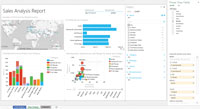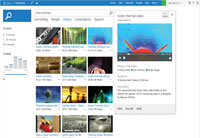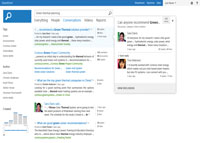In-Depth
Under the Hood of SharePoint 2013
A major facelift to the Microsoft collaboration platform puts social networking, cloud, business intelligence and modern apps at the fore.
Microsoft has refreshed just about every major product this year including System Center, SQL Server, Windows Server and, of course, the sweeping retrofit of its Windows client. As 2012 comes to a close, Microsoft is retrofitting one more major new product family: SharePoint and Office.
The release of the SharePoint 2013 and Office 2013 tandem this month for volume licensees marks a major revamp of the widely used Microsoft platform for enterprise collaboration and content management. Unlike key architectural changes made to the platform with SharePoint 2010, Microsoft focused more on giving SharePoint 2013 a significant facelift that changes the way individuals view, find, analyze and share mounds of information that may be widely distributed throughout an organization and beyond. The changes mean IT pros and developers must come up with new ways of managing data and building new modern apps designed for mobile devices.
While Office 2013 boasts a new interface consistent with Windows 8 and the GUI formerly known as "Metro" tuned for touch, along with synchronization with the cloud and other devices, SharePoint 2013 extends the Microsoft collaboration and information-sharing platform to a broader audience of workers while changing the way existing users interface with it. Combined with the recently released Microsoft SQL Server 2012 database and support for improved business analytics, those that deploy SharePoint 2013 will find it at the epicenter for parsing big data, which includes structured and unstructured information and how it's shared and analyzed (see "SharePoint 2013 Raises the Bar on User-Driven BI and Big Data,").
The SharePoint upgrade comes as the platform has crossed a milestone shared by few Microsoft products. At the annual SharePoint Conference in Las Vegas last month, Microsoft revealed that SharePoint is now a $2 billion-per-year product. Though Microsoft is known for having about 10 products that generate at least $1 billion a year, only a small handful, such as Windows and Office, have an annual $2 billion run rate. At last count, Microsoft said 135,000 organizations use SharePoint and 700,000 developers have built SharePoint apps since its 2001 debut. The SharePoint Conference was a de facto launch event for IT pros, developers and partners to learn about the new release.
Like many of its core products, Microsoft releases major upgrades on average every three years. SharePoint 2013 comes a bit sooner -- its predecessor SharePoint 2010 was released in June 2010. Simply put, the changes to this release are less architectural on the server side, yet support for multi-tenancy presents new use models and parity with the cloud version of SharePoint offered in the Microsoft Office 365 service.
Jared Spataro, Microsoft senior director for SharePoint product management, says the new release is a broad overhaul designed to make workers more productive by bringing modern social networking concepts to the workplace. "In the past we've positioned SharePoint as a platform that we marketed toward IT," he told reviewers in a recent teleconference.
Until now, Microsoft has marketed SharePoint as a platform for businesses to build on, "something for them to use essentially as a business collaboration center of gravity," Spataro continued, noting the tagline for SharePoint 2013 moves way from that idea, instead focusing on its use to get things done. "We're characterizing SharePoint 2013 as the new way to work together and we're really excited [about] what we've done to actually deliver on this promise," Spataro said.
 "We're characterizing SharePoint 2013 as the new way to work together."
"We're characterizing SharePoint 2013 as the new way to work together."
Jared Spataro, Senior Director for SharePoint Product Management, Microsoft
Unlike previous upgrades of SharePoint -- which typically are rolled out incrementally over a number of years -- the 2013 release promises to work its way into enterprises much faster, many experts say. A Forrester Research Inc. poll of 153 clients who already have SharePoint found 68 percent planned to introduce the new version within two years -- 37 percent within the first year and 31 percent within two years. What's interesting about that finding is 70 percent of that sample said they've already upgraded to SharePoint 2010.
That's more upbeat than a survey sponsored by SharePoint managed services provider Azeleos Corp., which finds 28 percent plan to deploy SharePoint 2013 within the first year of its release and 26 percent in two years, or a total of 56 within two years. "They're still bullish on the platform," says Scott Gode, Azeleos VP of marketing. Optimistic projections such as those reverse a pattern by which organizations typically are at least two versions behind before they upgrade, due to the tendency by shops to want to recoup their investments over a period of years.
Forrester analyst Rob Koplowitz reasons that disappointment with end-user features in SharePoint 2010 might explain the willingness to buck that trend. "This is conjecture here, but it could be around the social experience," Koplowitz says. "The feedback on the social facilities in SharePoint 2010 was pretty dismal. That might be the driver, but others include the need for improved document and records management. Also, it could be they're trying to move to a more stable development environment."
Microsoft and testers agree that SharePoint 2013 introduces a long laundry list of significant changes, including improved synchronization capabilities, which allow individuals to ensure access to the most-current version of a document or other content type from any device; project and task management centered around Outlook; faster and more refined search; and a new application development model that leverages an online store such as the iTunes App Store, Google Play and, of course, Redmond's own burgeoning Windows Store.
Perhaps the most noticeable change in the new release is that it extends the SharePoint sites model to bring social networking and activity streams to the forefront.

[Click on image for larger view.] |
| Figure 1. The new Dashboard Designer and Excel Services 2013 offer improved business intelligence. |
Emphasis on Enterprise Social Networking
"Social is central to everything you do in SharePoint 2013," says Christian Buckley, a SharePoint MVP and director of evangelism at Axceler Inc., a supplier of SharePoint governance, reporting and security tools. "Going in and looking at your My Sites is basically like a Facebook page. If anyone mentions you it shows up on your activity stream. People can follow you and you can follow people and projects, tags, events -- and any changes to that automatically show up on your activity stream."
Indeed, the social networking features in SharePoint 2013 are modeled after Facebook and Twitter, incorporating activity streams and allowing workers to bring the same behaviors of following people as well as projects and other objects. "For me, the biggest additions are the "@" symbol to look up people to reference in social activity updates, the new communities with badges to game-ify collaboration, and the ability to follow not only people but also documents, sites and tags," says Brian Alderman, director of technical resources at Mindsharp, a global provider of SharePoint training to enterprise users. "SharePoint 2010 was really missing the last piece to truly encourage users to adopt social and invest the time in social tagging."
 "I believe the improvements in the social networking space will be a turning point for those organizations that were skeptical on the implementation and use of My Sites."
"I believe the improvements in the social networking space will be a turning point for those organizations that were skeptical on the implementation and use of My Sites."
Brian Alderman, Director of Technical Resources, Mindsharp
When clicking into sites in SharePoint 2013, it's no longer an assortment of sites but a list of sites a user follows. With newly added intelligence in SharePoint, suggested sites come from a new recommendation engine available across different business objects such as those found in a typical news feed. People, documents, sites and tags have the intelligence to recognize what an individual is working on. "I believe the improvements in the social networking space will be a turning point for those organizations that were skeptical on the implementation and use of My Sites," Alderman says.
For groups with focused areas of interest, SharePoint 2013 introduces Community Sites, where people can gather to discuss ideas and thoughts around a subject area. Members are awarded points and badges for creating valuable content within the Community Site. "I feel that this particular social feature within SharePoint will be well received within the SharePoint ecosystem and facilitate greater SharePoint adoption," notes Asif Rehmani, a SharePoint MVP and solution architect at SharePoint-Videos.com, a provider of education and support. "The moderator of the site can also reward people for being active collaborators in the community," Rehmani adds.
The New Cloud-First Model
Microsoft began delivering on its cloud-first model last year with Dynamics CRM, which brought the same functions to the online version as the on-premises software. Now it's doing the same with Exchange, SharePoint, Office and other key products. Microsoft is upgrading its Office 365 service, which is built on the SharePoint 2013 code base. "This could be the last major release where we see SharePoint Online in Office 365 and SharePoint on-premises released at the same time," says Buckley.
"The move from SharePoint 2007 to 2010 was largely to get it more enterprise-ready or capable of scaling out," says Sean McDonough, chief SharePoint evangelist at Idera Inc., a provider of SharePoint migration, monitoring, security and management tools. "The move from SharePoint 2010 to SharePoint 2013 is primarily about making the platform ready for multi-tenancy, for cloud providers and Office 365 and all those folks who seek to make SharePoint available to other environments."
Microsoft has stated it's the company's intention to bring feature parity to the best possible extent between the cloud and on-premises, and has committed to start rolling out updates to the cloud before they're available as service packs and cumulative updates on-premises, McDonough notes.

[Click on image for larger view.] |
| Figure 2. SharePoint 2013 boasts improved management, storage and search of video files. |
Except for where SharePoint resides, there's not a whole lot of difference between using it in the cloud or on-premises -- though that will impact what kind of software users can run. That will be the biggest constraint for folks that go to the cloud. Like earlier versions of SharePoint, the 2013 release will continue to support custom and ISV-built apps that are sandboxed and designed to run on server farms.
Office 365 isn't the only option for running SharePoint in the cloud. The new multi-tenant architecture of SharePoint and Windows Server 2012 means organizations may opt to run it in other instances that might be more suited for running older SharePoint apps as well as new ones. One option will be to run SharePoint Server instances in Redmond's own Windows Azure service, as well as in those of third-party cloud providers such as Dimension Data and Rackspace US Inc., which offer both shared and dedicated hosting services. "If you have more than 2,000 users, a dedicated solution can be much more cost-competitive," says SharePoint MVP Jennifer Mason, a consultant with the Rackspace SharePoint practice.
SharePoint App Store Model
Those opting to run SharePoint in the cloud via Office 365 or hybrid cloud-premises scenarios -- something that will play well in organizations with widely distributed and mobile workers, as well as for those looking to use it to bring in outside partners, contractors and customers -- will need to build applications that run on the new Microsoft Apps for SharePoint 2013 marketplace. "Folks who are on-premises have much more control over their systems. They can install software that's in this category of full-trust farm solution, which allows you to do more with SharePoint than in the cloud," McDonough says.
One of the problems with full-trust farm solutions, he points out, is that poorly written software can bring a SharePoint system down -- which is why Microsoft came up with the new application model where the apps don't run within SharePoint but rather invoke standard Web capabilities such as HTML5, JavaScript and CSS. SharePoint users can also opt to build apps in Java, Python, Perl and other programming languages.
On the Apps for SharePoint 2013 marketplace, there are a handful of applications designed for the new environment including AvePoint MyView, Dell Quest Social Hub, Nintex Workflow Platform, Pingar Metadata Extraction, SharkPro Software SharkPro Project View, Timesheet from MAQ LLC and a Facebook integration app. It remains to be seen how quickly existing SharePoint and traditional .NET developers make the move, experts say.
Jeremy Thake, an enterprise architect at AvePoint Inc. -- a longtime provider of enterprise SharePoint governance and infrastructure management software -- believes they will make the move quickly. "The new app model takes the risk out of customizations from an upgrade perspective and allows for much more flexibility than the sandboxed solution model," he says. He notes that, out of the gate, there are not many apps in the store, but believes the marketplace will grow exponentially.
"The app model is a very powerful alternative in that you can either move the processing power to the devices that the users are using, which increases the Bring Your Own Device [BYOD]-type model, or take it completely to the cloud through their on-premises or public cloud usage models," says Sriram Jayaraman, director of technology for enterprise solutions and business intelligence at Aditi Technologies, a systems integrator that has worked with a number of early adopters of SharePoint 2013.
Moving forward, Jayaraman predicts more applications that are administrator- and management-focused are going to be farm-based solutions, and more and more apps that are end-user focused will go to the app model. "It's a much more comprehensive and compelling model, and adds a lot of flexibility for the developers," he says.
Document Sharing and Sync via SkyDrive Pro
Just as the new SharePoint cloud architecture has brought about a new app model, it also changes the nature of the heart of the platform: document management. Managing, synchronizing and sharing documents becomes much easier, thanks to the evolution of the SharePoint Workspace feature that has evolved in the platform following Microsoft's acquisition of Groove Networks, the company founded by former Microsoft Chief Software Architect Ray Ozzie. SharePoint Workspace was the tool that allowed for offline document access and file synchronization.
The new document store replacing Workspace is a centralized cloud service called SkyDrive Pro, which works much like the consumer-based SkyDrive service, except it's designed to be controlled by IT. Enterprise administrators can provision and manage the service that lets users store, synchronize and share business tasks. A user can store files either in private or shared folders; synchronize them with the PC he's working on; and have them updated on other devices and with others in a group.

[Click on image for larger view.] |
| Figure 3. The new Conversation View offers Facebook-like discussions among workers. |
"SkyDrive Pro is really a SharePoint service," Microsoft's Spataro says. "It brings with it the back-end richness of SharePoint. All of the content that's stored in SharePoint -- here in this SkyDrive Pro capability, it can be managed in a way you'd rigorously manage other content. All of the versioning, policies, all of the workflow, all of the lifecycle, all applies to this content and can be used in a way that lets you do a nice job of managing your critical information in enterprise settings."
AvePoint's Thake says using SharePoint Workspace to move documents to and from the SharePoint 2010 repository is unpredictable and was subject to document library scalability limitations. "In SharePoint 2013, SkyDrive Pro is a new attempt at taking your content offline and replace SharePoint Workspace," Thake says. "The experience of taking your documents offline has also been improved by simply clicking the sync button. This is much more of the Dropbox experience that I hear is massively being adopted for its ease of use in businesses."
SkyDrive Pro will also bring more control over My Sites, Thake says. "I see more organizations being open to the implementation of My Sites -- as they provide some of the well-known and liked functionality of Facebook, Twitter and LinkedIn -- now that it's easier to share and protect information with the SkyDrive Pro integration," he says. "These new enhancements make it more appealing as a tool instead of an isolated playground for users." Thake adds that SharePoint 2013 also introduces a new concept of "Share," which assigns what permissions users and groups have with two clicks. From a governance perspective, requesting access to a site can more easily be traced.
Search Gets Faster
When Microsoft released SharePoint 2010, it added more-robust search capabilities as an extra in the form of the FAST Search Server, which is now baked into SharePoint 2013. FAST Search Central Admin sites are now integrated in Enterprise Search in SharePoint 2013.
"SharePoint 2013 enables me to find things much more quickly with quick document previews in the Web browser, much better search refiners on the left-hand side, and subtle improvements like 'view library' and 'send,'" Thake says. The search function also provides improvements to relevance-ranking models across intranet and Internet sites, while pulling together results based on content and user interaction.
Administrative Considerations
Many of these new social features will be welcome by management looking to get workers to share more information beyond traditional workgroup and enterprise silos. But that will put new infrastructure planning and management requirements on IT. Whether running on-premises, in the cloud or both, SharePoint 2013 will require more components and therefore a more distributed architecture. Consequently, from a hardware and software perspective, SharePoint 2013 is much more demanding than SharePoint 2010, Idera's McDonough says.
The requirements just for a single server to run are a minimum of a quad-core 64-bit processor with 24GB of RAM. "It's pretty beefy hardware," McDonough says. Planning for an environment is going to take up more of an IT administrator's time, he adds. The IT pro needs to plan what will be needed for the environment, taking into key consideration the fact that services are more scattered throughout their environment.
"It used to be you could set up SharePoint 2010 and run all servers from one box, and do so happily if you're a small organization," McDonough says. "But with the new SharePoint 2013 application model, which entails setting up additional Web servers if you want to use the app marketplace, you'll need a much different infrastructure.